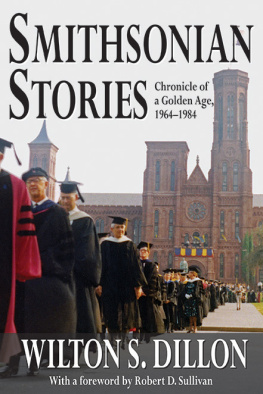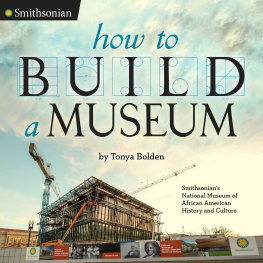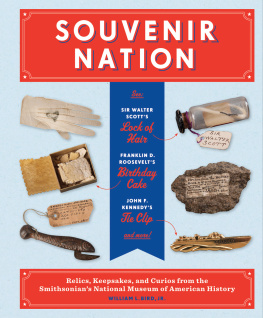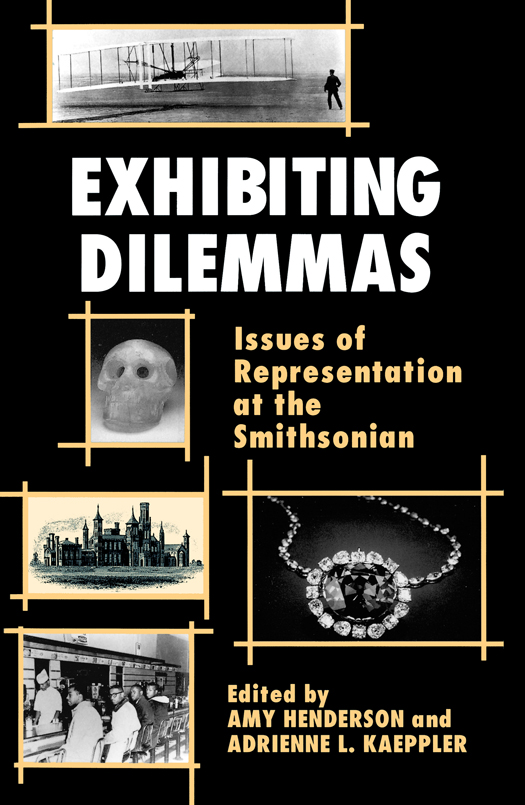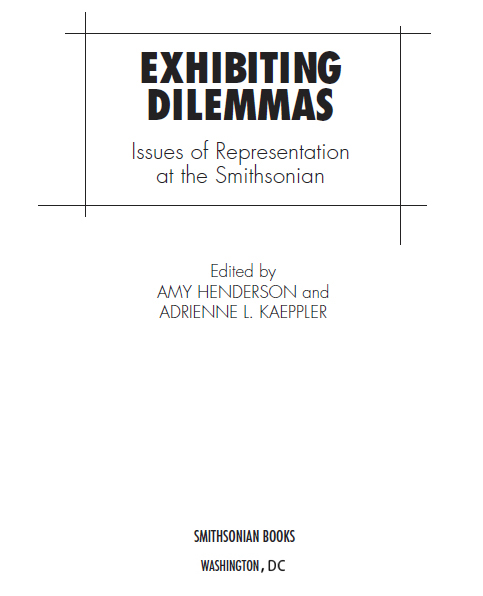1997 by the Smithsonian Institution
All rights reserved
Copy Editor: Jan McInroy
Production Editor: Jenelle Walthour
Designer: Kathleen Sims
Library of Congress Cataloging-in-Publication Data
Exhibiting dilemmas : issues of representation at the Smithsonian / edited by Amy Henderson and Adrienne L. Kaeppler.
p. cm.
Includes bibliographical references (p.) and index.
ISBN 1-56098-690-5 (alk. paper)
1. ExhibitionsWashington (D.C.) 2. Smithsonian Institution. I. Henderson, Amy.
II. Kaeppler, Adrienne Lois.
AM151.A96 1996
069.09753dc20 96-16140
British Library Cataloguing-in-Publication Data is available
For permission to reproduce illustrations appearing in this book, please correspond directly with the owners of the works, as listed in the individual captions. Smithsonian Books does not retain reproduction rights for these illustrations individually, or maintain a file of addresses for photo sources.
Ebook ISBN: 978-1-58834-551-6
v3.1
Contents
AMY HENDERSON AND ADRIENNE L. KAEPPLER
STEVEN LUBAR
WILLIAM H. TRUETTNER
RICHARD KURIN
MARY JO ARNOLDI
TOM D. CROUCH
JANE MACLAREN WALSH
WILLIAM YEINGST AND LONNIE G. BUNCH
ELLEN RONEY HUGHES
WILLIAM L. MERRILL AND RICHARD E. AHLBORN
WILLIAM W. FITZHUGH
SALLY LOVE
DWIGHT BLOCKER BOWERS
Introduction
AMY HENDERSON AND ADRIENNE L. KAEPPLER
The modern museum has come a long way since its emergence in the nineteenth century as a cabinet of curiosities. Instead of merely displaying objects, museum exhibits today draw on recent scholarship in art, literary criticism, and social history to offer broad interpretations about the origins, meaning, and value of objects, as well as theories about the thoughts and behavior of the people who made them and used them. Yesterdays cabinets of curiosities are today living, breathing founts of ideasalthough some of these ideas have not always found favor with the visiting public.
The emergence of the idea-driven museum has forced curators, the men and women responsible for acquiring objects and mounting exhibitions, to confront a wide range of social, political, ethical, and cultural issuesissues that hardly affected their counterparts in the cabinet of curiosities days. Those issuesalways challenging, sometimes vexingare the subject of this book.
Exhibiting Dilemmas is about how exhibition issues are being played out at the Smithsonian Institution. Published to coincide with the 150th anniversary of the Smithsonian, the book, written exclusively by Smithsonian Institution staff, shows how curators, historians, exhibit specialists, and educators at the Nations Museum have responded to the challenges of building a modern museum. But ours is also a shared journey, and the issues raised here are in many instances not exclusive to the Smithsonian alone. In that sense, this collection
Each essay deals with a particular issue or dilemma of modern curatorship. Some engage the challenges inherent in exhibiting the recent past and popular culture. During the last thirty years, for instance, the new social history, with its focus on history from the bottom up and its inclusion of previously marginal voices, has had a major impact on museum research, collecting policies, and exhibitions. This volume explores how decisions were made to begin collecting such objects as the Bunkers chairs from All in the Family, the M*A*S*H set, or the Greensboro lunch counter, and how the acquisition of such symbolic objectscontemporary and cultural icons in their own rightreflects the growing tendency in museums to contextualize collections and to use objects to illuminate and interpret a wider history. In a similar fashion, Exhibiting Dilemmas assesses the impact of the new art history, also largely contextual in interpretation, with art often being used to allude to a broad range of social and political issues.
Other essays deal with questions about the authenticity of objectsabout whether objects of dubious authenticity should be acquired, how it is determined if they are authentic or notand if they should be put on exhibit in any event. In short, what is the real thing? And does it always matter?
Another issue has to do with stereotypes. Some collections present a virtual social history of how changing interpretations mark a journey from one stereotype to another and if so, how. Finally, other dilemmas center on the repatriation of collections, on when and to whom objects should be repatriated.
The transformation of the museum from reliquary to forum has forced curators to reassess their role as cultural custodians. Increasingly, curators must ask if museums retain the responsibility of validating and confirming tradition. Who has the authority to interpret history to the publicindeed, who owns history? Is an exhibition always the best venue to present diverse interpretations of complex historical issues, such as the Enola Gay? How does an exhibit best present an interpretation that reevaluates the sacred narrative of a culture in which the public feels a wide ownership? Perhaps even more basically, what are the implications of the publics willing partnership in the museum metamorphosis from a more removed and isolated existence to a very public and commercial one? Although such issues of contemporary curatorship and exhibition are far from resolved, this book is intended as a contribution to that ongoing dialogue.
Early Smithsonian curators did not have to engage in such a dialogue. At the time of the founding of the Smithsonian, in 1846, its commitment to the increase and diffusion of knowledge was characterized mainly in terms of
Fig. I.1. West Range of the Smithsonian Building (The Castle), ca. 1862. Courtesy Smithsonian Institution Archives.
Fig. I.2. The National Museum of American Historys exhibition A More Perfect Union (1987present), focusing on the internment of Japanese Americans during World War II, exemplifies the kind of idea-driven interpretation increasingly typical of modern curatorship.
Today, as exhibitions have emerged as a major focus of Smithsonian research and outreach, they have left their safely removed cabinets for arenas of often intense public scrutiny (, Dilemmas of Curatorship.
In , Steven Lubars opening essay, Exhibiting Memories, discusses one of the central quandaries of current museum curatorship: how to reconcile history and memory, and particularly how to combine history and memory in an exhibition. It explores how the curatorial voice takes account of memory and personal recollection in translating history to the public and how the curator shares authority with the public without abandoning the responsibility of the curator-historian.
The debate over history and memory has illustrated at least one truth: Today there is no single, overarching agreement on historical truth. And because there are many histories, it follows that there are many ways of understanding. William H. Truettner addresses the ways in which the reinterpretation of historical truth has affected the emergence of the new art history in For Museum Audiences: The


